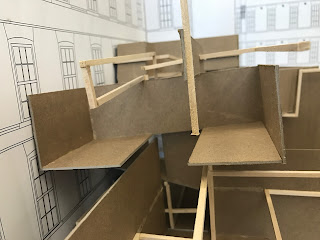Occupant 1:
young 20s, parkour tracer, films himself doing parkour movements
Occupant 2:
old 50s, parkour philosopher, retired, still does a couple of parkour movements but mainly enjoys teaching and reading
Occupant 1 starts as a basic traceur. He does two parkour movements outdoors, films them, he also watches those videos. Occupant two practices two parkour movements and reads in the spare time. Occupant 1 comes to occupant 2 to be a student. So, the philosopher teaches him everyday. The young traceur studies every morning an then foes practicing and filming. In the end of the day he watches videos in the home theater. The philosopher prefers meditating outdoors early in the morning and then teaches the traceur. During the day he tries to practice parkour. In the evening the philosopher reads and relaxes in the library.
Defining spatial qualities:
young 20s, parkour tracer, films himself doing parkour movements
Occupant 2:
old 50s, parkour philosopher, retired, still does a couple of parkour movements but mainly enjoys teaching and reading
Occupant 1 starts as a basic traceur. He does two parkour movements outdoors, films them, he also watches those videos. Occupant two practices two parkour movements and reads in the spare time. Occupant 1 comes to occupant 2 to be a student. So, the philosopher teaches him everyday. The young traceur studies every morning an then foes practicing and filming. In the end of the day he watches videos in the home theater. The philosopher prefers meditating outdoors early in the morning and then teaches the traceur. During the day he tries to practice parkour. In the evening the philosopher reads and relaxes in the library.
Defining spatial qualities:
 |
Outdoor filming for young traceur
Interconnected/wired vaulting
|
 |
Space for viewing videos for young traceur
Cracked confinement
|
 |
Space for reading, meditating and practicing for philosopher
Locked knolls
|
 |
Space for teaching and studying for philosopher and young traceur
Hidden framed path
|
 |
Outdoor filming for young traceur
Slices spaces
|
I like your spatial quality word pairs here, especially "cracked confinement." Not all of them read in the photographs you have here, so make sure that your photos track the quality you are defining, or re-evaluate quality. It may help to define your words individually and together, and also to keep a running list of synonyms and antonyms for developing your concept.
ReplyDelete